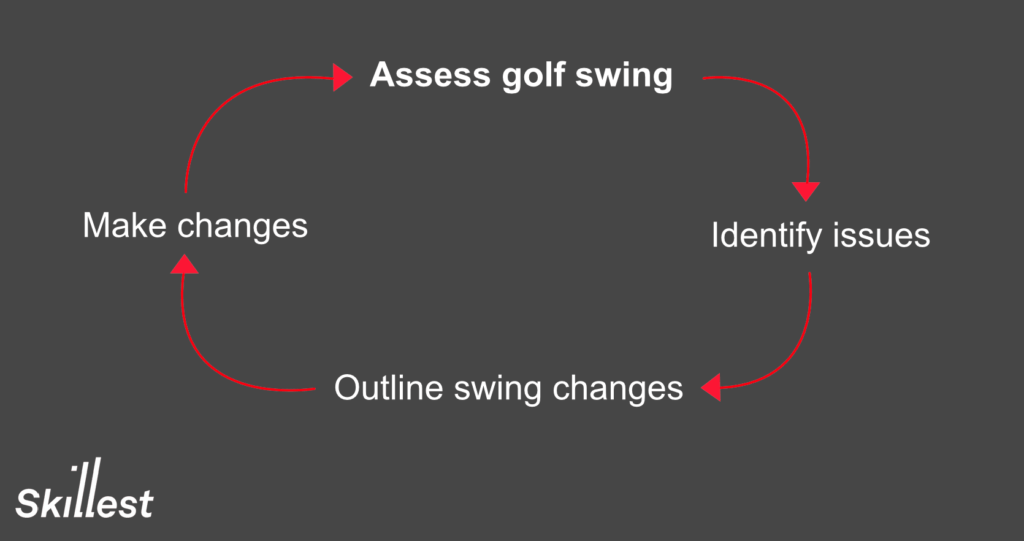A Guide to Improve Your Golf Swing
Posted by
To improve your golf swing you need to analyze it and understand which movement patterns are causing problems. You can then identify the changes needed to overcome your swing issues and work on implementing them.
Practicing with drills and training aids can help you build a feel for the new swing changes you’re working on. With enough repetitions, the new movements will become ingrained in your swing eradicating the old ones that caused issues.
The age-old saying “practice makes perfect” doesn’t always apply to the golf swing. For players with swing flaws, it’s more of a case of “practice makes permanent”.
Spending hours at the range with poor technique will do more harm than good to your golf swing. Building negative swing habits can take years to overcome.
Actionable Tips for Improving Your Swing
Get Help from a Professional Coach
With endless information on platforms such as YouTube, it’s easy to fall down the rabbit hole. People spend hours of their time trying to self-diagnose swing issues and waste hundreds of dollars on range balls in the process.
Unless you have a dedicated online golf coach, the advice you find on the internet won’t be specific to your swing.
If you’re committed to improving your swing and playing better golf, the best way to get started is with a lesson from an experienced coach. A good golf coach has seen every swing flaw in the book and will get you on track to improving your swing within minutes.
Golf lessons are so accessible these days and are available in a variety of formats. Online coaching is a great option for improving your golf swing. You don’t have to spend any time traveling to lessons and your swing coach is just a message away whenever you need them. Thanks to services like Skillest, you can get access to the world’s best coaches from the comfort of your own home.
Fully Commit to Your Swing Changes
When you adopt new movement patterns into your swing, it’s common to see some regression. This can mean that you shoot higher scores, or feel less confident over shots while working on swing changes.
It might be tempting to go back to your old swing but don’t give up, it’s completely normal for things to get worse before they get better.
Think about the long-term vision for your game. Golf might feel more difficult as you work on swing changes however, you’re working on habits that will improve your scores and make you a better golfer in the long run.
It can be helpful to separate technical practice from on-course play. When you’re on the course try not to think about your swing changes. It’s easy to become overwhelmed with mechanical thoughts, making it impossible to play a good round of golf. If you really have to, limit yourself to a single swing thought when playing on the course.
A practice routine will help you separate technical and on-course practice. If you need help creating a routine, golf coaches often offer custom plans that are dedicated to your game. Getting a training plan built and having a coach to hold you accountable is a great way to help you commit to your new swing changes.
To stop swing changes affecting your score you can dedicate time for them in the off-season. Spending the winter months getting the reps in means you will feel comfortable with your swing by the time the competitive season restarts.
Make Continual Improvement Your Goal
You still see the top tour professionals grinding on the range with a swing coach. This shows that even the best players in the world are committed to making continual swing improvements. Tiger Woods famously said, “the greatest thing about tomorrow is I’ll be better than I am today”.
The diagram below shows how you can commit to continually improving your golf swing:

Following the above process will help you become a better golfer season after season allowing you to continually break through your scoring barriers.
Use Swing Drills and Training Aids
Once you understand which parts of your swing need changing, it’s time to drill them into your new golf swing. Your coach should be providing you with drills to keep practicing to help you groove your new swing and make the changes feel more natural.
If you are struggling with making a change, training aids can be a great way to feel new movement patterns and get feedback when practicing. A training aid might be as simple as an alignment stick used in a variety of ways or there are specialized training aids to help with weight transfer, keeping your upper body in sync with lower body, making solid contact with your putter and more.
Your coach will be able to recommend tried and tested drills/training aids to help groove your specific swing changes into your golf game.
Swing Smoothly
Plenty of golfers are guilty of trying to hit the ball too hard. This often leads to a swing with poor tempo and bad contact. Many amateurs would benefit from reigning in their jerky swing and adopting a smoother one.
A smooth swing allows you to find more time in transition and stay well balanced. This often leads to an increase in distance due to an improved quality of strike, with the ball finding the center of the clubface more consistently.
Understand the Common Swing Faults
Some of the most common swing faults are listed below. These can help you identify issues that might be affecting your game.
- Incorrect ball position
- Poor balance/posture
- Swing path & clubface issues
- Bad tempo
- Incorrect sequencing
- Overthinking
These areas may help you identify areas of your swing that need improvement, but please note these are generalized issues. For advice specific to your own golf swing, you should consult with a professional coach.
